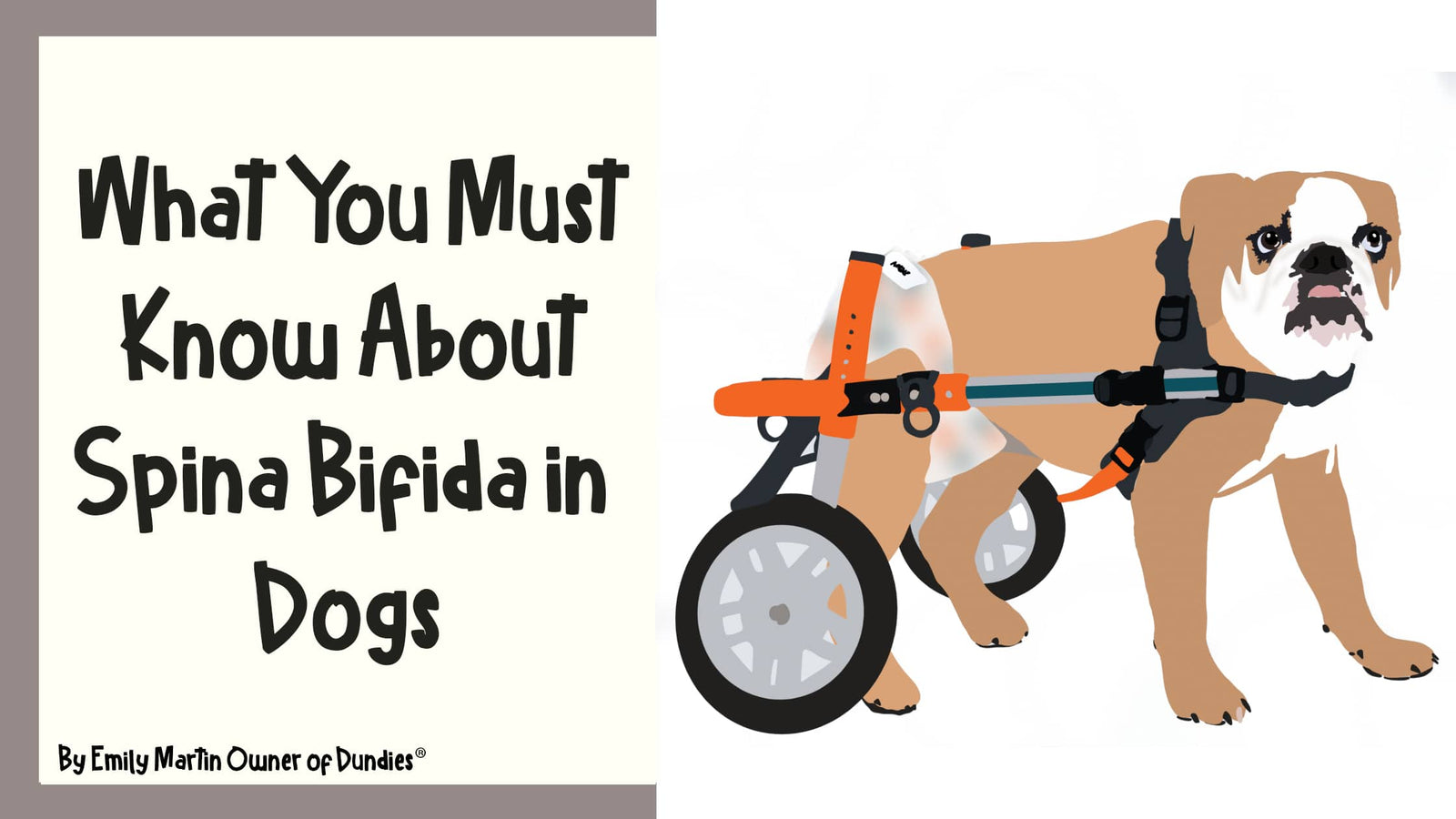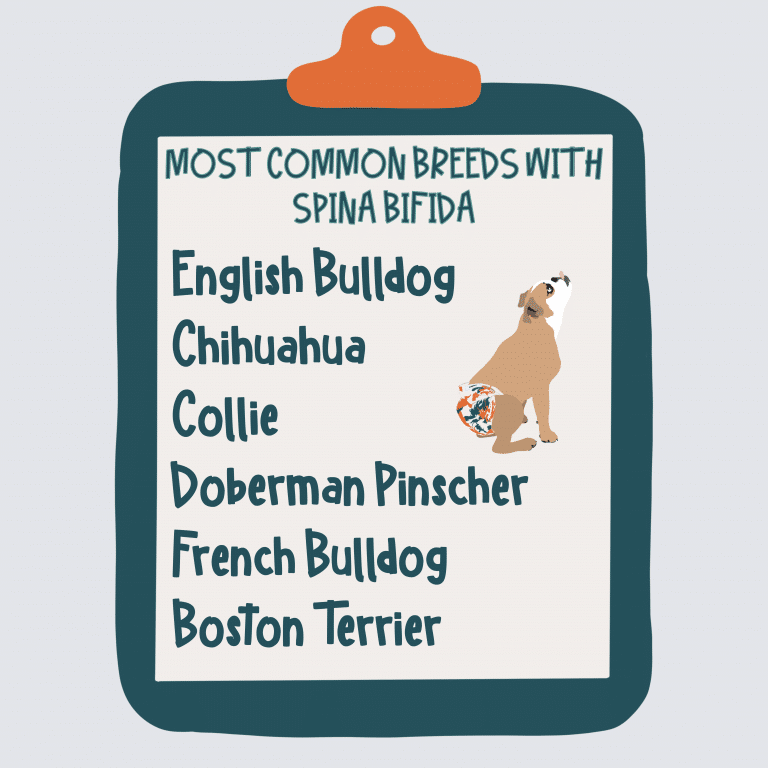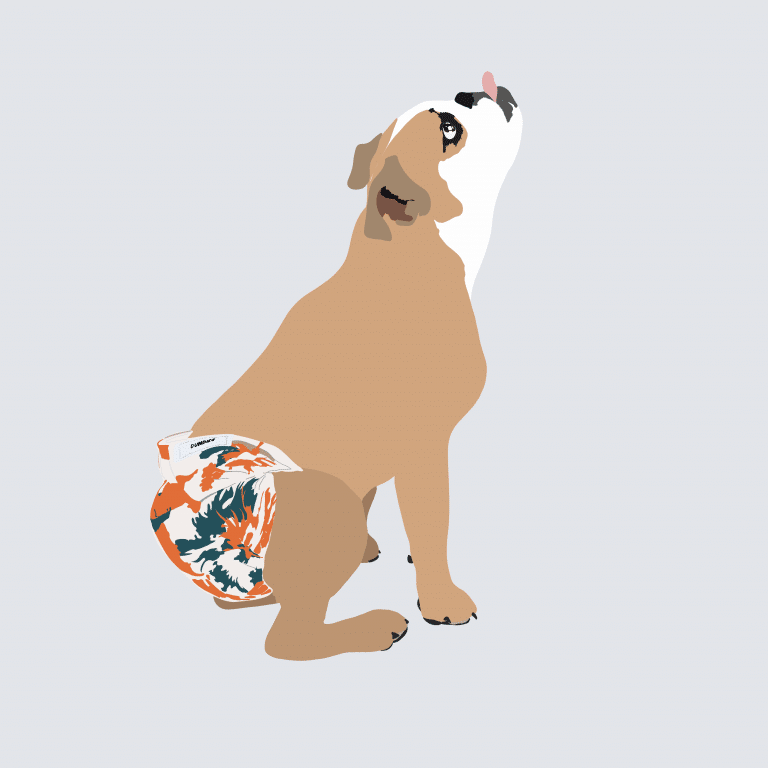
What is Spina Bifida in Dogs?
Spina Bifida is a congenital defect of the spinal cord in dogs. In a healthy dog the vertebrae of the spinal column encase and protect the spinal cord. In Spina Bifida cases, a deformity in utero occurs that prevents the vertebrae from completely closing, leaving a gap and exposing the spinal cord. This deformity is more commonly seen in the lower back, down near your dog’s tail, but it can occur anywhere along the spine. It is worth noting that Spina Bifida is a rare abnormality, and that most puppies born in Australia that display symptoms are euthanized before an official diagnosis can be made. This means that your vet is likely to have not seen a dog with this condition before. If your puppy is displaying any symptoms mentioned in this blog, bring up and discuss the idea of Spina Bifida with your vet. This condition is not a death sentence, and can be managed! I live and care for my own bulldog Sophie who has this very condition. There is no research that indicates mild Spina Bifida cases decrease the life expectancy of your dog.

What causes Spina Bifida abnormalities in dogs?
There is limited research behind the exact causes of Spina Bifida in dogs. Veterinary research indicates a possible genetic link, but it is not fully researched. If you are buying a puppy from a breeder, you can ask if there have been any past dogs in their litters or lineage that have displayed the symptoms of the condition. The most researched and believed cause for Spina Bifida formation is environmental factors. In utero, if the mother dog is exposed to or encounters certain situations, which can lead to her puppies to develop spinal cord malformations. Factors such as environmental toxin exposure, utero stress and nutritional imbalances during pregnancy have been linked to the development of this condition. One or more puppies in a litter can be affected.How is Spina Bifida diagnosed?
Dogs who have Spina Bifida will often begin displaying symptoms from 4 weeks of age, and the condition is usually diagnosed when a puppy is brought into the vet clinic with incontinence, hind leg weakness or paralysis. Your vet may conduct X-rays of your puppy’s spine to form a diagnosis. The X-rays will show a lack of vertebral arches or dorsal spinous processes. This is the top pointy part of the vertebrae. There can be one or more affected vertebrae pieces that have failed to fuse correctly. If a diagnosis cannot be made from an X-ray, your vet may recommend a CT or MRI scan is conducted. This gives the vet or vet specialist a clearer image of the spine and can lead to a more effective diagnosis if the X-ray is unclear. In more mild cases, spine deformities may not clearly display on an X-ray.
What breeds are most commonly affected and why?
There is no definitive link connecting gender of the pet to the condition but there are more dominant dog breeds and also cat breeds that are more susceptible to developing Spina Bifida. Interesting fact, not only domestic dogs and cats have been seen to suffer the condition, it’s also been found present in cows and horses in veterinary studies. Spina Bifida most frequently presents in breeds with a corkscrew tail. Even in short nub tails there are still full vertebrae pieces that make up the spinal cord. The way the vertebrae of the tail twist and develop in stumpy tail breeds is thought to have a connection to the condition. The most frequently observed breed to suffer from Spina Bifida is the English Bulldog. Studies show they are 3x more likely to develop the condition than other breeds, however any dog can develop Spina Bifida. In cats, the same statement is made, with the most common breed to develop the condition being the Manx, but this is not limited to other breeds also being diagnosed. Other commonly affected dog breeds are:- Chihuahua
- Collie
- Doberman Pinscher
- French Bulldog
- Boston Terrier
- Miniature Poodle
- German Shorthair Pointer
Signs and Symptoms of Spina Bifida

Symptoms and Signs of Spina Bifida
- Sacral dimple. A dip in the back close to the tail. This can be seen by a different hair pattern or an open lesion. In mild cases if you run your thumb along your dog’s spine, you may feel a slight dip near the tail.
- Urine incontinence. dribbling urine or retaining urine in the bladder unable to pass it themselves. This will require manual expressing
- Faecal incontinence. Passing faeces without knowledge and lack of anal tone
- Poor range of motion in the hind legs from dragging feet to complete paralysis
- Dragging the back legs
- Lack of pain receptors in the lower back. Your puppy may not feel you patting their lower back, tail or hind legs
- Hydrocephalus and coordination issues
Treatments
There is no known quick fix for Spina Bifida that will cure your dog’s symptoms. This is a lifelong condition. Current trials in the United States at UC Davis are looking into stem cell therapies that can help restore mobility in more severely affected cases. However, with the right tools, support and information you can manage your dog’s condition so they can live a long happy and healthy life
Severities and Types
Spina Bifida falls into different classifications of severity ranging from no symptoms through to full paralysis of the lower extremities. There are four main classifications but your vet or vet specialist will be able to provide you with more support in understanding your pets condition.Occulta
This is the most mild form of Spina Bifida and may produce no signs or symptoms. Your pet may only be diagnosed with this form of Spina Bifida if you are getting x-rays on other parts of your pet’s body and your vet notices it on the images. They may have a small dimple on their dimple on their spine, or no signs at all. You may never know your dog has this condition.Closed neural tube defects
In this classification, your vet may notice spinal defects on your puppy’s X-ray or CT images. Often symptoms with this severity are only mild and manageable. Your dog may have partial paralysis, dragging their feet or walking slightly wobbly, but they will still be able to walk. They may also have no issues with their mobility. Your puppy may also be showing bowel and urinary incontinence. Mild nerve damage may also be present.Meningocele
In this type, the spinal cord has developed normally but the protective membranes around the spinal cord push up into the deformed openings of the vertebrae. Surgical options can be a possibility with this type of Spina Bifida to remove the membranes pushing through the bone. The same clinical symptoms present as closed neural tube defects. Surgery will not cure the symptoms, but can make your pet more comfortable.Myelomeningocele
This is the most severe type of Spina Bifida. The spinal cord is often fully exposed, or there are multiple vertebrae that have deformities. Full paralysis of the lower limbs is often present with complete incontinence. There will also be a lack of sensation in the skin with nerve damage. Puppies with this severity are usually born with their spinal cords exposed and are often euthanised. Swelling of the spine can lead to the development of hydrocephalus. This condition can be managed but it is lifelong and can present with various complications and ongoing medical costs. Rescue groups and specialist vets can offer great support in helping you decide on the path of care if your dog is diagnosed with this type of Spina Bifida.
5 Complications of Spina Bifida to monitor
Urinary tract infections
Dogs with Spina Bifida and usually incontinent. When managing your pet’s incontinence, it is important to maintain good hygiene so they don’t develop UTIs. These may become unavoidable if your dog fails to completely empty their bladder and stale urine sits in the dog’s bladder causing irritation. If you notice your dog passing blood or dark urine or acting lethargic, book an appointment with your vet so they can test your dog’s urine. Antibiotics can be used to treat UTIs. The use of supplements like cranberry, D-mannose and making sure your pet is drinking adequate water can be used to support good bladder health. Talk to your vet or a pet nutritionist about managing your pets’ diet to help prevent UTIs.Skin infections and rashes
It is important to maintain good grooming and skin hygiene when caring for a dog that has incontinence so they don’t develop rashes. Ammonia burn on the skin (You can see pictures in our material matter blog here) and rashes from diarrhoea can develop. Maintaining a good cleaning routine by changing pet nappies frequently, allowing your dog to have outside time without a nappy on, wiping between changes and providing baths as needed is important. You can read more about nappy care in our FAP and CCC inflammation prevention tools. Using a zinc based nappy cream or pet safe cream, we personally love Bella Maree Belly Cream, or a medicated cream from your vet on any rashes can help make your dog more comfortable.Lacerations and injury to the legs
Dogs with Spina Bifida can have a lack of feeling in the legs can cause your pet to sustain injuries without knowing. It is important to keep a close eye on your dog’s back legs if they have limited sensation. Also keep an eye out on their toes and back nails. If they drag their feet, these can become worn down and bleed.Anal prolapse
Due to lack of tone in the anus, if your dog is experiencing constant soft stools, they can develop an anal prolapse. Take your dog straight to the vet if this occurs so your vet. The vet can put the prolapsed anus can be put back in, reducing any chance of an infection. If this is a recurring issue as your dog progresses from puppyhood into adulthood, the vet may recommend surgery to tack the bowel into place or to shorten it.Joint weakness
You might notice your dog developing joint weakness as they age and progress through puppyhood. Joint issues in the hips, knees, feet and front shoulders should all be monitored at regular vet visits. You can also incorporate supplements into your pets diet to support healthy joints. Your vet may also suggest injections to support the joints such as Cartrophen.
Dundies® Suggested management plan – Sophie’s Care
Always consult with your vet regarding management's of your dog’s Spina Bifida. A pet nutritionist can also support in diet advice and an animal rehabilitation specialist can support in mobility care.Hygiene and Bedding (nappy changes and baths)
To save your sanity as an owner and keep your dog and home fresh and clean it is a great idea to find a routine that works for you to manage their mess if they are incontinent. To support Sophie's incontinence we use Dundies all in one nappies and washable puppy pads. Change your pet’s nappy every 3-4 hours or immediately when soiled. Make sure your dog has nappy free time. Sophie has a minimum of three hours outside of her nappy in the yard. This lets the skin breath and reduces any concerns with ammonia burn developing. Dundies nappies are breathable so you pet’s skin can breathe while wearing them. No matter what brand you choose, always make sure the nappy is breathable. You can read more about this on our Material Matter Blog. Giving your pet a safe place to sleep is also important. You might prefer to give them a crate and crate train them. You can then line the crate with a bed that has a waterproof cover so any accidents are easily cleaned. Dogs with Spina Bifida will regularly void in their sleep without their knowledge. Dundies puppy pads are great to put on top of a bed as they are absorbent and also waterproof. Your dog can also wear a nappy when sleeping. Make sure to give clean your dog well when you change their bottom in the morning and provide nappy free time directly after. If you are using nappies on your dog that is completely incontinent, you will go through a minimum of 4 per day. If your dog is having upset bowel motions you may need up to 10.Expressing and monitoring of tummy and bowel
Spina Bifida in dogs can reduce the pets ability to fully empty their bladder. It’s important to make sure your dog can empty their bladder and bowel. Feel their stomach and balder area regularly and if you notice any distension, swelling, or it feels very firm head to the vet. If you pet needs helping emptying their bladder and bowels your vet can help you learn how to express your pet. Do not over express your pet, particularly if they have loose stools. Over expressing can cause trauma to the anus and lead to bleeding, bruising and prolapse.Support
Find a good support group! Facebook groups including the Dundies VIP group are fantastic resources. If you are not sure or have questions, finding someone to ask can really help ease your stress in caring for your dog. Caring for a disabled dog is stressful and without support it can lead to feelings of doubt and uncertainty, and this is completely normal! Various rescue groups also specialise in the condition and will more than happily provide you with tips and tricks.Diet
Supplements and additional health supports can greatly improve your pet’s health. Sophie's management plan includes taking cranberry and eating 1 meal a day as an adult dog of a balanced raw diet. Kibble can sometimes lead to loose stools. It’s important to find a food that works for your dog that gives them a medium to firm stool. Discuss diet with a canine nutritionist or vet. Provide access to water and make sure your pet is drinking well and limit the variety of treats they eat. Choosing one protein when providing treats, for example chicken breast, will give you an indication of anything that upsets your dog's digestive system. If you notice your pet gets an upset stomach from that particular treat, you can try a different one.Exercise and joint support
Exercise is important to help your pet maintain a happy healthy life. Provide your Spina Bifida dog with short walks or try exercises like hydrotherapy
Support Aid recommendations by Dundies
- Walking Wheels pet wheel chairs
- Bella Maree Natural Pet Products shampoo, creams and sprays
- Dundies
- Pet Ramps
- Pet Prams (coming soon to Dundies)
- Acupuncture, laser therapy and hydrotherapy
